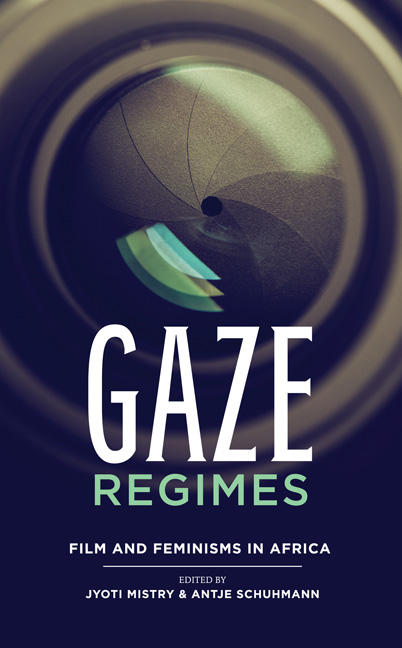Book contents
- Frontmatter
- Contents
- Acknowledgements
- Foreword: Goethe-Institut sub-Saharan Africa
- Introduction: By way of context and content
- 1 African Women in Cinema: An overview
- 2 ‘I am a feminist only in secret’
- 3 Staged Authenticity: Femininity in photography and film
- 4 ‘Power is in your own hands’: Why Jihan El-Tahri does not like movements
- 5 Aftermath – A focus on collective trauma
- 6 Shooting Violence and Trauma: Traversing visual and social topographies in Zanele Muholi's work
- 7 Puk Nini – A Filmic Instruction in Seduction: Exploring class and sexuality in gender relations
- 8 I am Saartjie Baartman
- 9 Filmmaking at the Margins of a Community: On co-producing Elelwani
- 10 On Collective Practice and Collected Reflections
- 11 ‘Cinema of resistance’
- 12 Dark and Personal
- 13 ‘Change? This might mean to shove a few men out’
- 14 Barakat! means Enough!
- 15 ‘Women, use the gaze to change reality’
- 16 Post-colonial Film Collaboration and Festival Politics
- 17 Tsitsi Dangarembga: A manifesto
- Acronyms and Abbreviations
- List of Contributors
- Filmography
- Index
3 - Staged Authenticity: Femininity in photography and film
Published online by Cambridge University Press: 20 April 2018
- Frontmatter
- Contents
- Acknowledgements
- Foreword: Goethe-Institut sub-Saharan Africa
- Introduction: By way of context and content
- 1 African Women in Cinema: An overview
- 2 ‘I am a feminist only in secret’
- 3 Staged Authenticity: Femininity in photography and film
- 4 ‘Power is in your own hands’: Why Jihan El-Tahri does not like movements
- 5 Aftermath – A focus on collective trauma
- 6 Shooting Violence and Trauma: Traversing visual and social topographies in Zanele Muholi's work
- 7 Puk Nini – A Filmic Instruction in Seduction: Exploring class and sexuality in gender relations
- 8 I am Saartjie Baartman
- 9 Filmmaking at the Margins of a Community: On co-producing Elelwani
- 10 On Collective Practice and Collected Reflections
- 11 ‘Cinema of resistance’
- 12 Dark and Personal
- 13 ‘Change? This might mean to shove a few men out’
- 14 Barakat! means Enough!
- 15 ‘Women, use the gaze to change reality’
- 16 Post-colonial Film Collaboration and Festival Politics
- 17 Tsitsi Dangarembga: A manifesto
- Acronyms and Abbreviations
- List of Contributors
- Filmography
- Index
Summary
Identity constitutes itself through the possible continuities offered by collective memory. This is also the case for gender identity, since cultural memory shapes the structures of individual memory. The concept of ‘destabilised identity’ was first used during the Second World War to describe the psychological damage of people who had lost their sense of place within a particular cultural continuity. But what are the channels through which cultural memory transmits knowledge, emotions and thus also identities? I am going to outline these ‘channels’ using the concept of the collective imaginary and, in doing so, attempt to show that gender identity is closely connected to the medial conditions of the given time – not only because collective memory relies on the storage system of the media, but also because the media form and its interconnected communities impact individuals and gender roles via those communities. Marshall McLuhan (1964) defined media not only as the conveyors of the message but also as the message itself, insofar as media demand different kinds of attention, modes of reception and thus emotionality. However, McLuhan failed to consider a crucial aspect of medial identity formation: the creation of symbolic gender roles. The symbolic gender order constitutes the most important point of contact between the ‘collective imaginary’, the media and the community. In the gender order, the collective imaginary that is formed by the media becomes visible, tangible; the imaginary is incorporated.
How should the concept of the collective imaginary be defined? It has nothing to do with the archetypes of CG Jung, which are characterised by ahistoricality and immutability; nor does it refer to the collective unconscious, in which are buried the traces of a common cultural tradition or the traumata of a nation. Rather, the collective imaginary is related to what the German philosopher Walter Benjamin called ‘ideal images’ (Benjamin 1982a:1226) or ‘images [that] belong to a particular time [and that] only become legible after a certain time’ (Benjamin 1982b:577). The collective imaginary, as I would formulate it, thus consists of the historically variable models or ideals thrown up by every epoch which contribute to the formation of the self-image and visage of society.
- Type
- Chapter
- Information
- Gaze RegimesFilm and feminisms in Africa, pp. 18 - 32Publisher: Wits University PressPrint publication year: 2015



